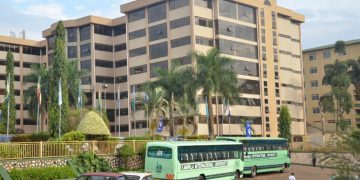At a press conference held today Tuesday 16th June 2020, a research team led by Makerere University presented a ‘Mathematical Model of COVID-19 dynamics in Uganda: Using a locally parameterized system to enhance intervention policies’.
The aim of the research from which the model by Makerere University is developed was to study the dynamics of COVID-19 in Uganda and use the results to provide comprehensive forecast of the disease’ trends. The model endeavours to provide appropriate evidence-based policy support to government on the timing and nature of intervention measures.
The research team that worked on the study is led by Prof. Joseph Y.T. Mugisha, a Professor of Biomathematics (Department of Mathematics, College of Natural Sciences). Professor Mugisha is also the Principal of the College of Natural Sciences, Makerere University. Other members of the team are: Dr. Juliet Nakakawa Nsumba (Makerere University), Dr. Joseph Ssebuliba (Makerere University) Dr. Amos Ssematimba (Gulu University), and Dr. Cliff Richard Kikawa (Kabale University).
The Vice Chancellor – Makerere University, Professor Barnabas Nawangwe and the Deputy Vice Chancellor –Academic Affairs, Associate Professor Umar Kakumba attended the press conference.
In his remarks, Professor Nawangwe welcomed the press to Makerere University thanking them for informing the public about the Covid-19 research and innovations developed by staff and students of Makerere University.
He said ‘as we all are aware, COVID-I9 is a big global challenge and Makerere as a lead research institution is working to provide solutions to the pandemic at the national, regional and global levels with our partners’. He reiterated his appreciation of the Government of Uganda for providing funds through the Makerere Research and Innovation Fund that enabled the team to undertake the study presented.
Study Conclusion
The findings of this study show that the immediately implemented measures by the Government of Uganda averted thousands of cases that would have overstretched the health system within a couple of months. Without significantly altering the current situation, measures on partial lockdowns and use of masks are insufficient to stop COVID-19 and as such the disease will remain endemic in the population. In all the assessed scenarios the disease would be wiped out in the case where there are no infected arrivals beyond the first 58 days and in this case the disease would be wiped out within 200 days.
With the worrying situation of increased reported cases in our neighbouring countries, the impact of Uganda’s interventions would be greatly affected as results show that doubling the imported cases would almost triple both the maximum number of hospitalized individuals and the number of undetected cases.
Screening of truck drivers faces a challenge of reagent limitation, imperfect test accuracy, arrival of asymptomatic and latently infected individuals that may pass as false negatives during screening as well as the porosity of some of the national borders. Thus, adoption of alternative less-risky means of essential cargo delivery (e.g., by rail and ship services) combined with quarantining of all entrants for a duration not shorter than the incubation period should be enforced.
Amidst challenges of social-economic impact of COVID-19, agitation of lifting lockdown may downplay the impact of intervention measures and the study findings highlight the importance of optimal timing and magnitude of lockdown easing. Effectively phased-out ease of lockdown needs to be well studied and executed to avoid the possibility of a second wave.
Study Recommendations
1. It is not advisable to eased lockdown by releasing 50% of susceptible population for the Ugandan situation with current 3200 hospital beds and not all are of ICU-like capacity, because within 100 days the COVID-19 related hospitalization demand would have already overwhelmed the current resources.
2. Since the consequences of hospital acquired infections go beyond merely increasing the number of cases, their mitigation should be given high priority.
3. Lifted to a 75% level, the yet-to-be detected cases in the community have potential to start a second and more disastrous epidemic wave. However, with enhanced surveillance and contact tracing, gradual easing by releasing smaller percentages of susceptible individuals from lockdown can still be safely executed sooner than the optimum 210 days for up to 75% susceptible level.
4. The issue of handling truck drivers mingling at service and testing centres at border crossings should be reinforced – preferably, government should set up treatment and isolation facilities as close as possible to the testing border points not to overwhelmed the existing regional facilities, optimize scarce handling resources and also to minimize stigma and community discontent. This would in addition reduce the time frontline workers are exposed to the risk of infection amidst lack of well-equipped ambulances
5. Since latently infected individuals can only be detected after latent period, effort should be put on obtaining information on where the drivers have been few days before arrival to understand the risk of admitting persons from high risk regions of neighbouring countries. The risk of imported cases is not only posed by those who test positive but also due to false negatives and latently infected individuals.










Discussion about this post